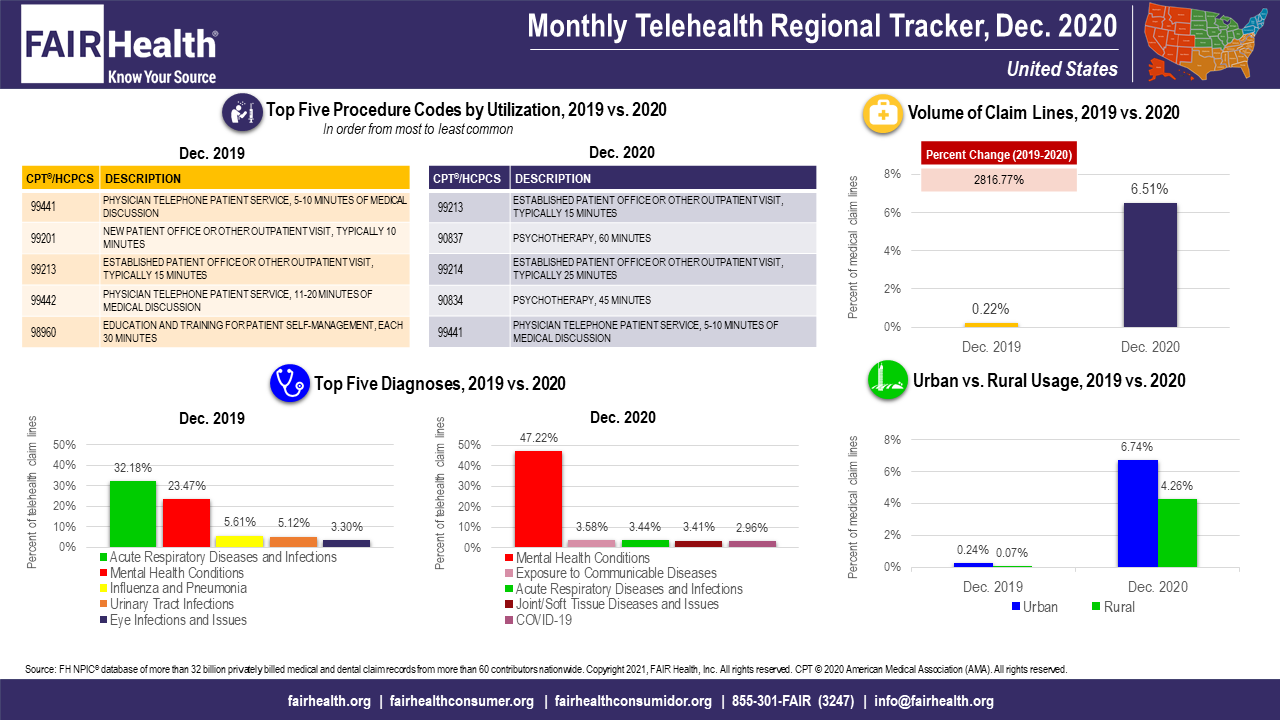- Center on Health Equity & Access
- Clinical
- Health Care Cost
- Health Care Delivery
- Insurance
- Policy
- Technology
- Value-Based Care
Telehealth Claim Lines Increase 2817% From December 2019 to December 2020
Robin Gelburd, JD, president of FAIR Health, discusses the dramatic increase in telehealth claims throughout 2020.
Telehealth claim lines increased 2817% nationally from December 2019 to December 2020, rising from 0.22% of medical claim lines in December 2019 to 6.51% in December 2020, according to new data from FAIR Health’s Monthly Telehealth Regional Tracker (Exhibit 1). From month to month, the telehealth share of medical claim lines rose 8.3 percent nationally, from 6.01% in November 2020 to 6.51% in December 2020. The data represent the privately insured population, excluding Medicare and Medicaid. With the addition of December, the Telehealth Tracker now has a complete 12 months of data for 2020 as compared to 2019.
Exhibit 1. Monthly Telehealth Regional Tracker, December 2020, United States
Source: FAIRHealth

Trends in the 4 US census regions (Midwest, Northeast, South and West) were similar to those in the nation as a whole. In each region, there were large percent increases in volume of telehealth claim lines from December 2019 to December 2020; smaller increases occurred from November to December 2020 in every region but the Midwest, where the volume of claim lines dropped 0.3%.
Higher telehealth utilization from March to December 2020 in comparison with the same months in 2019 was likely a result of the COVID-19 pandemic, as patients and providers turned to telehealth as a way of reducing the risk of disease transmission associated with in-person visits.
Other notable findings of the December Monthly Telehealth Regional Tracker concern the top five telehealth diagnoses by volume. In December 2020, COVID-19, for the first time, became one of the top five telehealth diagnoses nationally and in every region. Its prominence may reflect the surging number of COVID-19 cases and relatively fewer telehealth visits for other conditions, such as the flu, cases of which have been unusually low this season.
From November to December 2020, mental health conditions continued to be the number one telehealth diagnosis nationally and in every region. Exposure to communicable diseases continued to be number two on the national list of telehealth diagnoses and to appear in the top five in all regions. Exposure to communicable diseases was likely related to the pandemic, as patients contacted providers via telehealth out of concern they had been exposed to COVID-19.
Also notable was the lack of change in the top five procedure codes by utilization. There were no changes nationally or by region from November to December 2020 in the top five procedure codes, even though there had been changes in at least some regions in previous months. This suggests that the telehealth procedures being performed might have stabilized by December.
About the Monthly Telehealth Regional Tracker
Launched in May as a free service, the Monthly Telehealth Regional Tracker uses FAIR Health data to track how telehealth is evolving from month to month. An interactive map of the 4 US census regions allows the user to view an infographic on telehealth in a specific month in the nation as a whole or in individual regions. In addition to data on the volume of claim lines, diagnoses and procedure codes, each infographic includes findings on urban versus rural usage.
FAIR Health’s Monthly Telehealth Regional Tracker now provides a complete picture of the year 2020 in comparison to 2019. As the COVID-19 pandemic persists, we will continue to monitor how the pandemic affects the evolution of telehealth.
For the Monthly Telehealth Regional Tracker, click here.
About the Author
Robin Gelburd, JD, is the President of FAIR Health, a national, independent nonprofit organization with the mission of bringing transparency to healthcare costs and health insurance information. FAIR Health possesses the nation’s largest collection of private healthcare claims data, which includes over 32 billion claim records and is growing at a rate of over 2 billion claim records a year. Certified by the Centers for Medicare & Medicaid Services (CMS) as a national Qualified Entity, FAIR Health also receives data representing the experience of all individuals enrolled in traditional Medicare Parts A, B and D; FAIR Health includes among the private claims data in its database, data on Medicare Advantage enrollees. Gelburd is a nationally recognized expert on healthcare policy, data and transparency.
Health Outcomes of Dually Eligible Beneficiaries Under Different Medicare Payment Arrangements
December 1st 2025Within the same physician groups, 2-sided risk in Medicare Advantage (MA) was associated with higher quality and lower utilization for dually eligible beneficiaries compared with fee-for-service MA and traditional Medicare.
Read More
